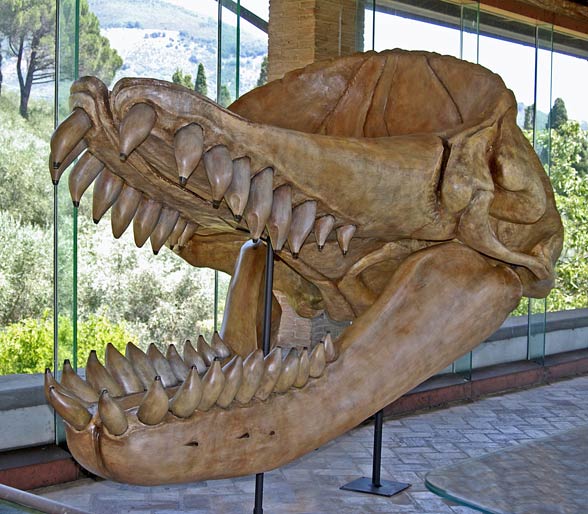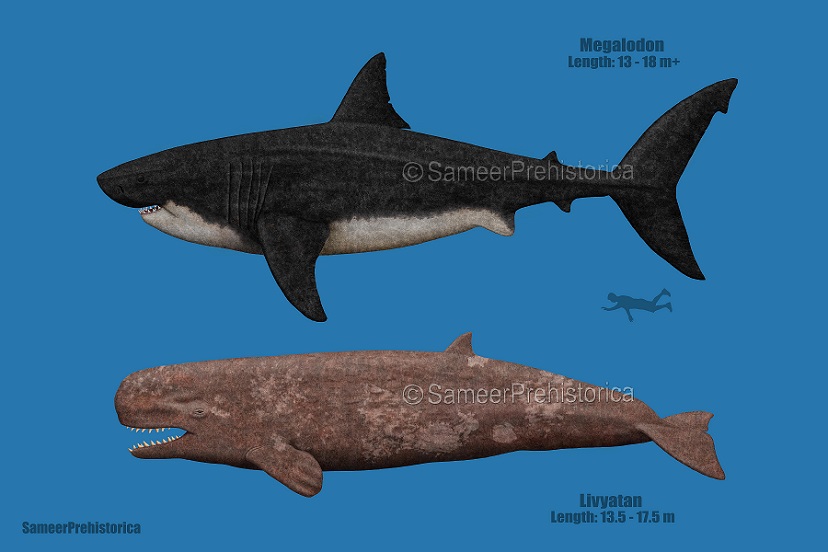For this blog I wanted to discuss an often overlooked variety of prehistoric animals, the whales. In my opinion, the most impressive animal of this group was Livyatan Melvillei, a toothed whale that rivaled sperm whales in size and appearance.

Livyatan lived between 5 and 10 million years ago during the Miocene era. Remains have only been found in Peru near the Southern Pacific, but like most whales, these animals likely had a much wider range.

As said earlier, these whales strongly resembles sperm whales given their toothed jaws and bulbous head, but unlike their more gentle relatives, Livyatan was an apex predator of its time. Sperm whales have a thin and weak lower jaw, and no teeth on the upper jaw, limiting their diets to soft-bodied animals like squid. In contrast, Livyatan had a wider, robust mouth with massive teeth on the upper and lower jaws. Its relative jaw muscle size was comparable to that of killer whales of today, and had the largest teeth of any carnivore in history, at about the size of a two liter soda bottle. Their teeth were also densely packed and curved outwards to provide extra grip on struggling prey. They likely used these capabilities to feed on baleen whales.

Given their predatory adaptations and their inherent intelligence as mammals, it is possible that Livyatan used hunting strategies similar to that of killer whales, such as tiring their prey out via direct pursuit and then drowning them once they were exhausted. With orcas, this is usually done in groups, but Livyatan’s size suggest it was possibly a solitary animal. It is also possible that they used their large melon (the big round part of their head) to ram prey, or struck from below to capture prey as great white sharks do. Livyatan also had a bulbous forehead, as mentioned and pictured before, which is a trait shared by sperm whales. Beluga whales look most similar to livyatan in this regard. This structure is made up of the melon and the spermaceti organs, which are used in echolocation, which was et another tool Livyatan had at its disposal while hunting.
Oftentimes, people draw comparisons between Livyatan and Megalodon (a giant shark) due to their similar size and predatory nature. There was a period of time in which both of these animals would have existed simultaneously, and it is therefore possible that they were in direct competition with one another. Megalodon would have possessed a stronger bite and was maybe 5 feet longer, but livyatan would have possessed superior speed and intelligence, so it is hard to say which of these animals would have been apex.

Overall, Livyatan Melvillei would have been an incredible animal to see alive, and comparing them with sperm whales, serve as an impressive example of how the food chain shifts over time.
Sources:
http://www.prehistoric-wildlife.com/species/l/livyatan.html
https://www.nyit.edu/medicine/livyatan_melvillei
https://carnivora.net/livyatan-melvillei-v-sperm-whale-t8891.html
https://www.nationalgeographic.com/science/article/behold-leviathan-the-sperm-whale-that-killed-other-whales
This is a very interesting blog! I’ve heard some about the Megalodon, so it was interesting to read about an animal similar to that, in size and being an apex predator. The fact that the teeth of this animal were so large is also super cool. It was also interesting that they might have shared hunting techniques to that of modern killer whales. Its super cool that despite all this time passing, modern animals still share traits and behaviors of animals of the past.
Yet another intriguing blog post! It’s fascinating to learn about prehistoric creatures like Livyatan Melvillei and the unique adaptations they developed to survive in their environment. The discovery of this species sheds light on the evolution and diversification of whales and their ancestors, providing valuable insights into the natural history of our planet!